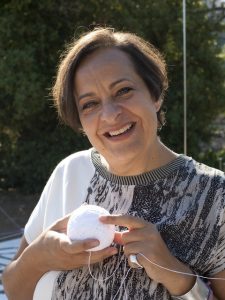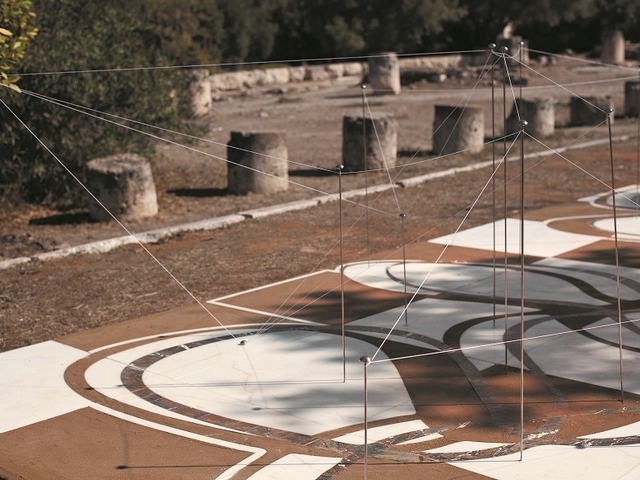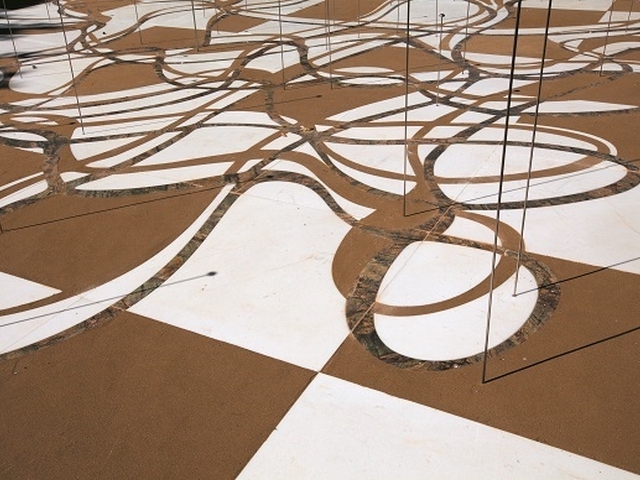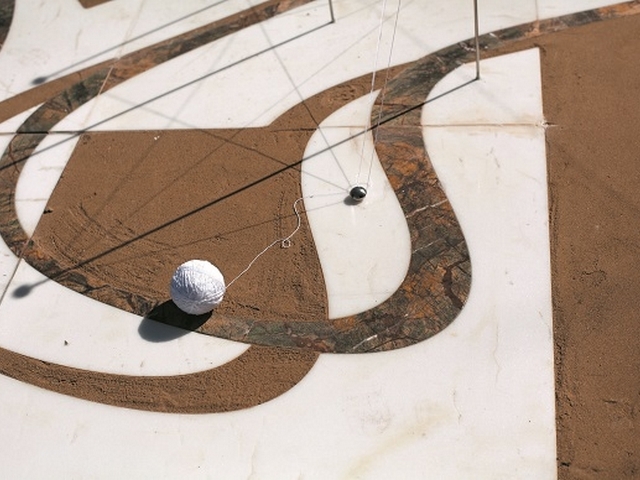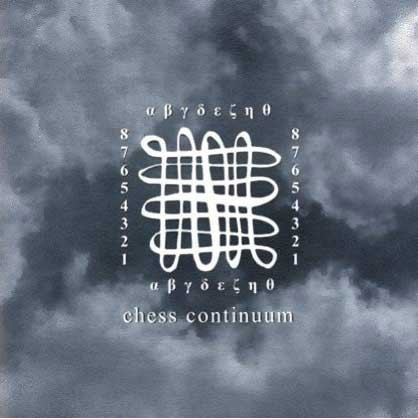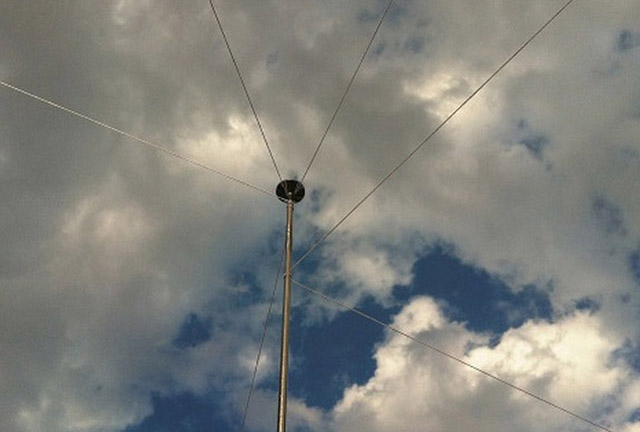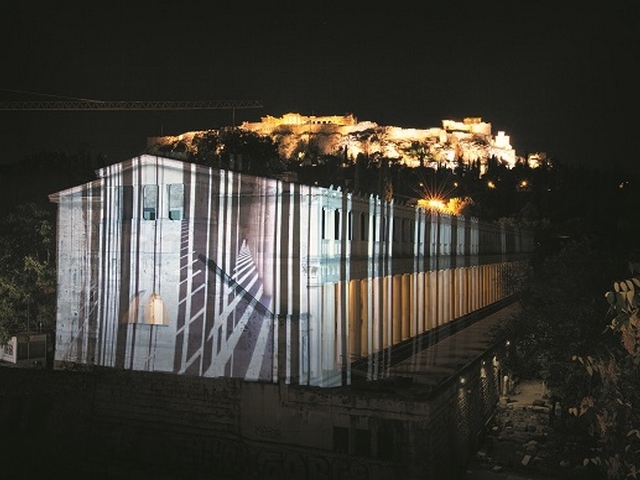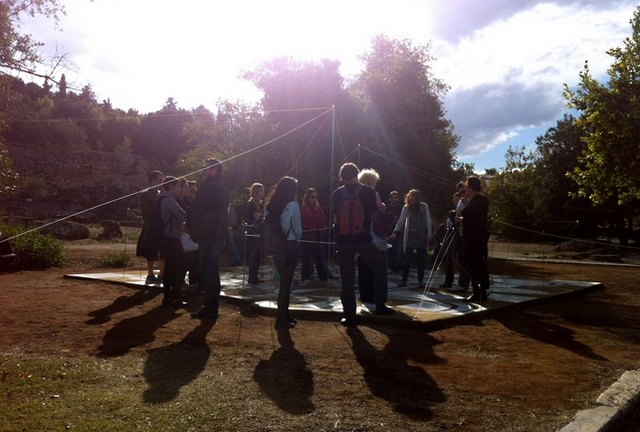INTERVIEW: Aemilia Papaphilippou
Aemilia Papaphilippou is among the artists that their work is characterized by a basic pattern-axis: hers being “Chess Continuum”. Since I first met her, immediately after her participation in the Biennale of Sao Paulo in 1991 where she was representing Greece, till today, her work evolves in time and space, unfolding. Just like the “Pulsating Fields” of the present, which is the first commission of the NEON foundation for public art in the city, a project where contemporary art creates a public dialogue with the City and Citizens. A work of triunity: so powerful as the installation is in the Ancient Agora, experiential, high vibrational, coalescing, as the performance is, of international standards beyond the narrow limits of Greece, as the video projection is upon the Stoa of Attalos, without counteracting ancient Greek beauty. Aemilia Papaphilippou is a contemplative artist, so the dialogue with her, like life’s journey, is meaningful and of the essence, done on the occasion of a really great, monumental and structured work: the “Pulsating Fields”.
By Efi Michalarou
Photo: Giorgos Gripeos, Anastasia Lambrou, Kostas Prapoglou, Constantinos Raptopoulos
Mrs. Papaphilippou, you are presenting the art piece ”Pulsating Fields”, at the Ancient Agora, within the “City Project 2014” which is an initiative of the NEON foundation. How did this collaboration come about, and how have you responded to this call?
I first encountered NEON’s declaration announcement in the press and felt it displayed an awareness of culture being a process of interconnectivity: that instigated me and I approached them. I sent an email asking for a meeting, declaring also my basic concept: the ideogram of 1992, Chess Continuum where a chess map is drawn in its entirety by one single line revealing it to be basically a grid, a nexus of interconnectivity. That I felt might interest them. Furthermore, since NEON professed interest in supporting contemporary art displayed in venues other than the expected it felt probable that they might also show interest in my need to enter an archaeological place with a twine at hand. I was, to my surprise, indeed received by the director Elina Kountouri and given the opportunity to further expand my thoughts on the notion of culture being a continuum; a weaving pattern of sorts. Through this process it was decided and it was announced that I would be the first artist commissioned to do a “city project” somewhere in the historical city centre which was unspecified at the time. Shortly after that I was invited by the Ministry of Culture to participate in the exhibition of the Greek E.U presidency in Brussels, “Nautilus: Navigating Greece”, where I met Nikoletta Saraga, the archaeologist in charge of the Ancient Agora. There, in the spur of the moment, talking over dinner about culture as continuum (without her knowing that we could have the support of NEON) she invited me to do “something” in the space of the Ancient Agora! Of course, I couldn’t be happier since the Ancient Agora is after all the birthplace of Democracy. It is in fact the most appropriate place for Chess Continuum as net-consciousness (to use a term of my own), or to put it in classical terms as a dialectic synthesis of opposing assertions. Of course my proposal -a most detailed study- underwent the approval of the central archaeological committee. In all, I feel that this nearly magical coming together, this simultaneity of intentions and volitions, reflects collectivity as a phenomenon of synchronicity in a way that exceeds us all.
Tino Sehgal presented his work in the Roman Agora and you in the Ancient Agora, simultaneously; these being two completely different projects with different artistic approaches and different references. Was it a challenge for you or a fruitful artistic dialogue?
Knowing that Tino Seghal would be showing a piece in the Roman Agora, (besides being given the chance to experience this piece -that I read about- in person), I felt it definitely established a dialogue between us although in reality I was never given the opportunity to meet him. I therefore couldn’t be happier to be exhibitting along an international artist who has won such recognition. In this sense what happenned -and was reflected in criticisms written to that matter- was to have parallely two contemporary artists within archeological spaces dealing with what art is. For him something which is an everyday process in our meditteranean culture -being involved in a rather openended dialogue I mean- was proposed as a guided performance. For me the piece per se, permeating all the manifestations of Pulsating Field, aims to change our awereness of ‘chess’ from a symbol of dominion to a a chessgrid of interconnectedness, a nexus of continuuous change. If we recognize this, respect then is revealed to be a natural law. Both pieces I think deal with memory and the way we archive notions and ideas… the way therefore we weave culture.
The site of the Ancient Agora, is extremely difficult, yet your proposal is daring and risky, in the sense of confrontation with the aura, the energy of the space, and history also. However, the artistic result confirms and co-signs, not only that you worked hard and in many levels so a contemporary work not to rise above history, nor history, the collective memory and consciousness to assimilate the contemporary work. Have you been entertaining this idea yourself long before the call of NEON?
Thank you! Yes! Οf course. I’m drawn I guess to places, outside the established venues, where it is least expected: deciding, for example, not to exhibit in the decorous space cleared up within the mess of the Zenetos FIX buiding – for the inaugural exhibition of National Museum of Contemporary Art – but do the “Fixed in Flux” projection within the wreck of the remnant building was actually quite an accomplishment; because I decided not to go along with the seemingly proper and respectable façade of the “Museum”. Now that I think back I even did a video-projection of “Chess Continuum” on archeological remnants, out in the public, in the city of Chania, back in 2006, if I remember correctly. I was immpressed to see that despite the bitter cold people stopped to see the piece for a long time… All this stems from an an awareness that all culture is a continuum, a technology of thought and a strategy for evolution where art works are both the tools but also the accomplishments. As declared in my statement: All pulsates; like the waves of the seas or your mobile phone. Oscillating, mutating, yet connected -as if by threads- into a coherent network, a field, a grid, intangible, imperceptible but absolutely real. Chess Continuum takes place, since it always entails synthesis of opposing assertions. Within this dialectic -often labyrinthine – battle, the instincts at play are one and the same as those of survival. But of course! What else? In the need to understand nature so as to survive we have devised solutions, symbols … culture as meta-nature. In this sense art is a tool of expression but also one of change; altering our conception of Self and Cosmos. We weave and un-weave – all and each and everyone individually – our future, and the birthplace of this awareness is in the ancient Agora of Athens. In this line of thought – call it net consciousness – respect is a natural law.
What does it mean for you as an artist the dialogue within the city- the Citizen and the State, in the literal, original meaning of the words?
Chess Continuum as in city, citizen,civility, civilization.
Watching all the three projects ”Pulsating Fields”, one realizes that the “Chess Continuum”, with which we came in contact with your work, is contained, indicating that there is a continuity and relevance, not only as “Elective Affinities”, but as a thread, as so nicely is used, invisible and unites all of your work.
It is indeed the case. From the weaving Chess Continuum of 1992 to the Pulsating Fields of today, the twine reels out evolving…It requires that I take intitiatives that -if not coming from the work itself- wouldn’t even cross my mind.
Although on your artistic carrier your presence, was a kind of “alternative performance”, here the relation of absence – presence, which was a balance in between, was deleted, making your presence felt with an excellent – emotional performance, eliminating the ”I”, creating, through the visible, invisible threads of union-action and inter-action with the viewers, as we experience it. Your performance is a collective project, where several people have collaborated, seems very simple, but it is extremely powerful, high vibrational experiential work, what is the reason for that and what was your objective in the planning stage?
Thank you again! Indeed all my work is characterized by performativety- from installations, most characteristically the 1991 Sao Paolo Biennale chessboard “Playing in the Fields of Time there is no winning ever”, to interactive projects. I have for a long time now been trying to instigate all kinds of interactive situations: from an exhibition I curated titled “The Fabric of Art” where I asked my fellow artists to basically interact on each other’s work. (Funding was withdrawn at the last minute and it never took place since unfortunately the company funding it went bankcrupt ). Later on I tried to design an interactive magazine that was issued for a couple of times:Atypon. It preceded the internet and yet I had in mind something in the logic of the interaction that the internet allowed further on. It was too soon though… For this performance I kept it simple: I asked people that I deeply respect their work; Efthimis Theodosis, a musician, who constructs his own musical organs being also a videoperson, Mariela Nestora an accompliced choreographer and dancer of yelpdanseco, to interact with me and vibrate space and time so as to make people realize how densely interrelated and interconnected we all are. Furthermore I asked from fellow artists, under the same criterion of respect, to help out, to spread the message, the thread… Anastasia Lambrou, Margarita Petrova, Eleanna Martinou, Zoe Said, but also people who I feel can be generous in the offering of their energy including our volunteers. Because the way I see it the basic performance in all, is being simply alive, present in the here and the now, and willing to be open to life…In this sense we all have to realize that what we perceive as Ego is a just construct, just a devised mechanism, through which we are called to act and perform what we come to experience as Self and Cosmos.In this awareness, that is consciousness, the Ego expands so as to loose all boundaries and feel at one with a flow that cannot be described but only experienced.
The most impressive work is the video projection in the Stoa of Attalos, a Monumental project, of international standards, ripe and concentrated, but also with a sense of proportion, which permeates your entire project. How easy was it to keep this balance and how this occurred?
The projection is indeed a spectacle seen from a distance whereas the marble platform and the performance require one’s bodily involvement. In all however I’m interested in the somatosensory input as a way of computing (making sense out of) information. In other words I’m not sending out information to be received, (falling into categories of ideas and notions already established) but I’m asking people to make sense out what is out there. To solve a riddle while making their own route towards understanding -what they end up understanding- to be therefore unique. I therefore call upon creativity as a sense of play, and that is part of what makes us human. As for the projection I always felt that the Ancient Agora and other places of archaeological interest are breathing at night, reverberating… The colonnade of the stoa of Attalos fascinated me. I photographed it in different times of the day and when I placed the photographs side by side I realized that they reminded me of the barcode!: The binary intermittence of 0, 1 that codifies information through pulsations, through the absence or presence of current. This observation along with the similarity of white noise to the sun sparking on the sea are the basic tools for the video projection- combined of course with the Chess Continuum ideogram propagating that both nature and culture alike are pulsating fields. Lately I was fortunate enough to enter Hephestus temple. There It was evident that what seems big from the outside is in fact rather small from the inside. This happens exactly because the colonnade reverberating light magnifies the effect of the building, maintaining, at the same time, a sense of proportion according to the human scale.
Have you thought to perform similar projects in other places, in Greece or abroad, within the city, creating this dialogue between contemporary art, ancient art, architecture, urban landscape and the viewers as players and conveyors of your project?
I have. At this point I would like to mention Kostas Prapoglou, archeologist but also curator and art critic on contemporary art, based in London, who not only contributed a beautiful text in the catalogue but was the very first to know of my need to intervene with a twine into an archaeological space, to believe in the feasibility of this vision, support me and stand by me every step of the way! I also had the support of Yiannis Vlassopoulos, a researcher mathematician on string theory at Ihes, France, who has been an active dialogue partner of 17 years, who has also contributed a beautiful text in the catalogue. Without the active support of these, but also other friends, Anastasia Lambrou being my assistant, Giorgos Gripeos photographing for the catalogue, Maria Maneta doing the 3d images –to name only few- I wouldn’t have accumulated the strength to see this project through.
Would you like the project to remain in the field, or to pass on the torch as characteristically you said, to the next artist? Who could potentially be?
As I said previously I understand culture as an interweaving continuum: part of what I wanted to put forward is that there is contemporary art in Greece and this is not to be treated as an oxymoron. We have, and I’m talking collectively here, (let me include the National Museum of Contemporary Art, the Onassis Culture Center, Neon if you like, myself included, or whomever else has decided to take cultural responsibility) to realize that importing well-established artists is rather easy .No risk is involved, after all they are already established in cultural environments elsewhere. Greek venues furthermore are beautiful and being also of historical importance they instigate genuine interest. Even more now in times of financial crisis. We have to understand therefore that the goal is to be able to support, and basically export let me add, what can contribute to the international dialogue that contemporary art is. We are far from it. Otherwise, by not acting, we are only allowing cultural intervention, if not cultural takeover. The right balance of what happens culturally elsewhere, with supporting cultural production here, has still to be achieved. And in this sense of course I would like what I experienced, with the support of NEON foundation, to continue: artists producing new works for the specific circumstances, as I did: Greek or non-Greek to that matter is irrelevant. However what is of the outmost importance is that this cultural production will be inspired and produced here, and if it is of high calibre, gradually, will be included in the cultural dialogue that is contemporary art. Of course I’m aware that I’m putting into action my notion of a museum “Fixed in Flux” as was my work titled for the inauguration of the National Museum of Contemporary Art I mentioned before. Being fixed upon what is in constant flux, and I mean art and creativity, would have – if FIX opened up and exhibited the making of the Museum as a work in progress- amounted now to an already functioning and most innovative, internationally, Museum. I’m convinced that prim programs that are designed as if we were somewhere else and not in the chaos we live in, of false beautifications as facades, do not contribute to our cultural making. In this sense of course I want to establish a legacy of giving the torch, and believing that NEON has a similar understanding, I ‘m sure we will get to discuss further on culture from Greece.
Concluding, we would like to mention two issues: in “Together”, the participation and the collaboration, which was evident in the performance, but also in the other two projects, since they are complementary to each other, there is sequence. What was the role of young people with whom you worked and what does this mean for you and your work?
As I already mentioned “Togetherness” is something that cannot be explained nor described. It is an expanding of consciousness into an awareness that pulsates in sync with a flow that feels organic and absolutely present. Being however with people “Together” implies that there is a collective identity they share: that is why the people I selected to actively participate in the performance are people who I believe share the awareness of what is to be an artist, if you want a human being, in terms of sharing. But let me add here a note on NEON volunteers: this is a very important feature of NEON! It breeds a new generation who really work towards change! Knowing that I could rely upon the fact that they would be present -generous to receive people- was an important key for the designing of my piece. Culture gets to be transmitted from human to human, like a handshake. You cannot achieve a handshake by yourself. It needs the meeting of opposites much in the same way of combining strands of DNA. In this sense culture is the DNA that makes us human.
What was the response of the public? What is the most intense-strong reaction or comment that will remain indelible in your memory? (We know that your exhibition visited from a wide audience: children, blinds, adults, art people, and tourists).
People liked the work beyond my wildest expectations. I think what happened, beyond the fact that they were surprised positively to find a contemporary art installation within the context of the archaeological space, was that the piece managed to resurface -through a memory inherent in the body- the basic core of culture as freedom, harmony and respect. I’ m talking about the fact that the instant people decide to step upon the piece they move slowly and inquisitively, having to find way and balance both the labyrinthine strings and the pattern on the surface. In this way what resurfaces is the memory of learning to walk. Walking is not a thing we should take for granted -after all we worked hard for nearly two years of our lives to learn to balance ourselves. Bipedalism is a cultural trait and has made us into humans and involves balancing opposite hemispheres of our brain much in the logic of Chess Continuum. In this sense we know that culture is indeed cultured, gradually and with the outmost respect gets to be cultivated, transforming who we are, our mind, our brainwave patterns, consequently our bodies. So I’m in between the blind person who asked to re-enter the piece and the Greek lady in her 60’s who after her initial surprise of finding a contemporary art work in the archeological space said: “Congratulations to all of us – we’ve changed!”
First Publication: www.dreamideamachine.com
© Interview – Efi Michalarou
Info: Pulsating Fields, First Commission: NEON, Ancient Agora of Athens, Duration: 8/10-30/11/14, Days & Hours: Everyday 8:00-15:00, Video projection every Saturday, 20:00, Stoa of Attalos, http://neon.org.gr/gr
* Special Events: Performance at “Pulsating Fields” on Sunday 23 of November, 13:00

